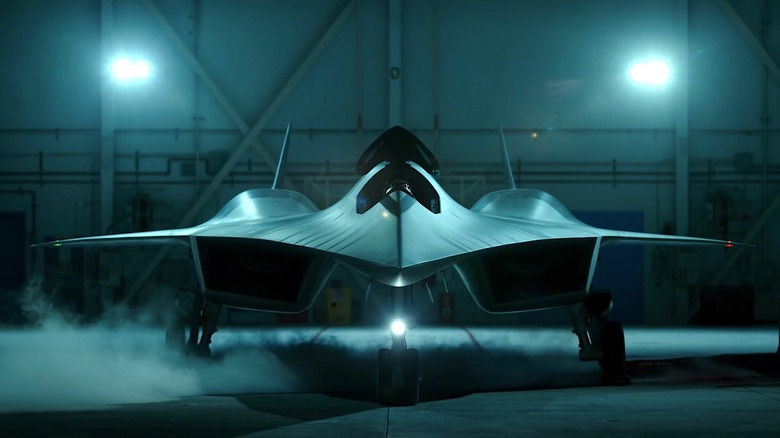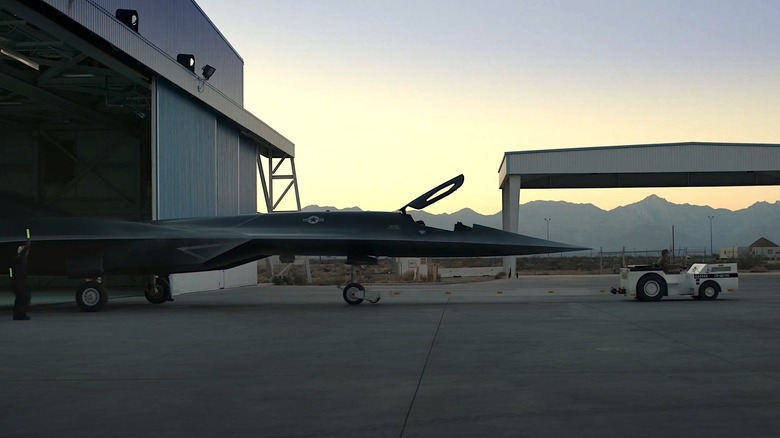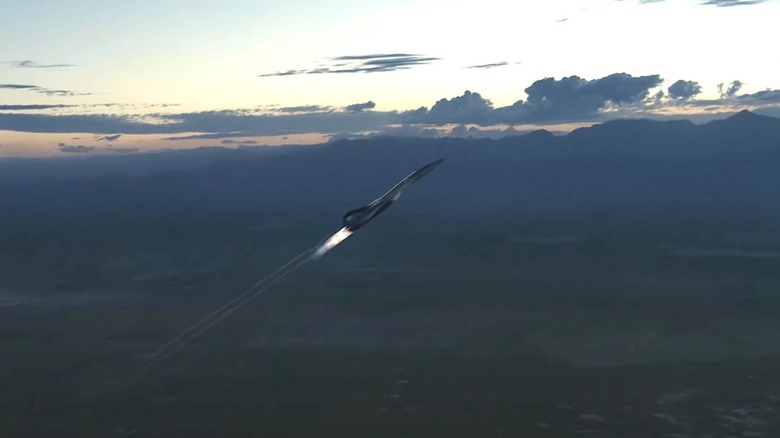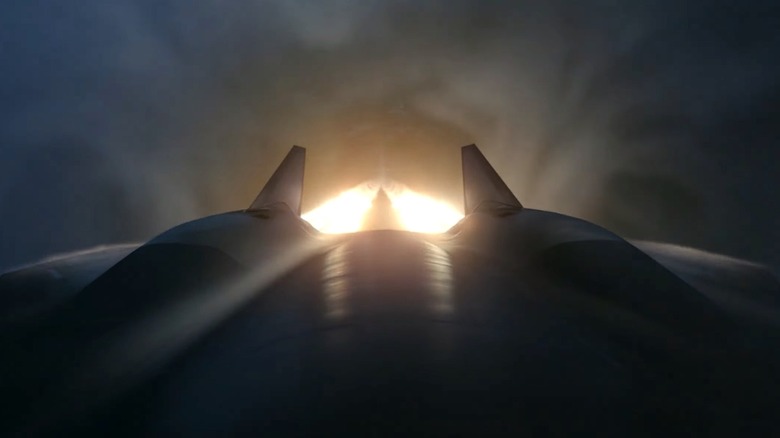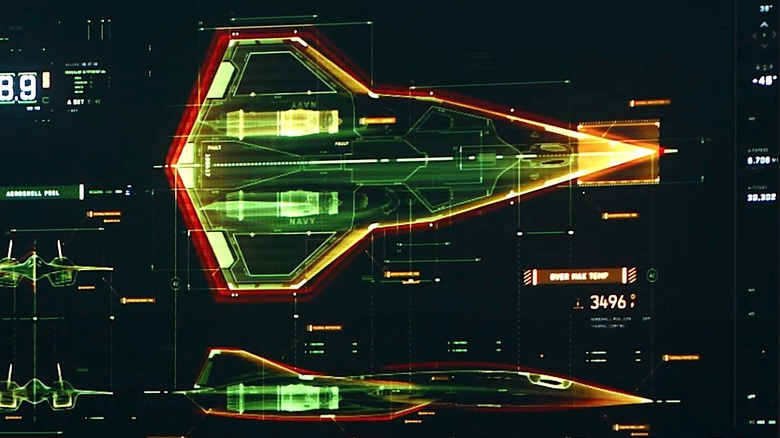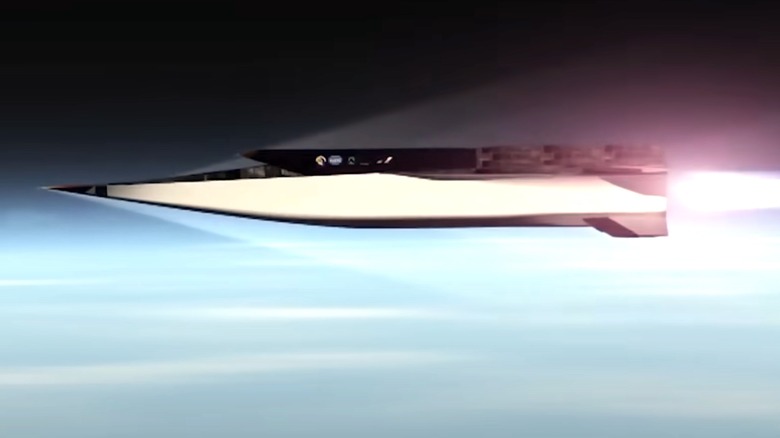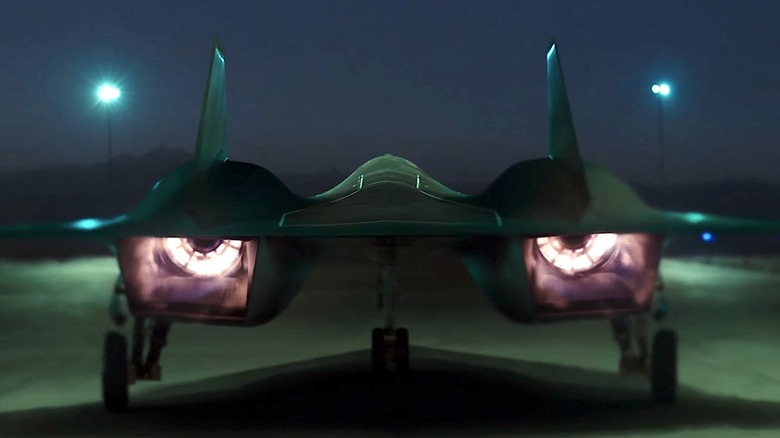5 Fascinating Rumors About The SR-72 'Darkstar' Jet
Few aircraft in the history of aviation have been as mythologized as Lockheed Martin's fabled SR-72. Dubbed the Darkstar by some aircraft enthusiasts, the long-in-development hypersonic spy plane has reportedly been part of the legendary aircraft manufacturer's Skunk Works lab since 2007 — the same lab responsible for some of Lockheed Martin's most iconic jets of all time.
So many years later, the craft remains as secretive as ever. So secret is the SR-72 that some questions arise as to whether or not it even exists, and it seems unlikely that Lockheed will be doling out new information about the craft anytime soon. As for what we know about the Darkstar, the aircraft was conceived to replace Lockheed's high-altitude SR-71 Blackbird, which remains the fastest military jet in history despite being retired.
Of course, virtually anything else you've heard about the Darkstar is essentially unconfirmed conjecture, and there's been no shortage of wild theories surrounding the aircraft over the years. Here are five of the more intriguing rumors we've read about Lockheed's so-called Darkstar jet.
Darkstar is probably not the SR-72's name
Given how long Lockheed's SR-72 has reportedly been in development, curiosity surrounding the craft has waxed and waned dramatically. Interest in the craft was reinvigorated and then some in 2022 thanks to the jet's presence in the blockbuster film "Top Gun: Maverick." The Darkstar is the first jet we see Tom Cruise's Pete "Maverick" Mitchell fly in the action spectacular, and the scene in question finds him pushing the experimental craft past Mach 10 before chaos ensues.
The Darkstar test scenes rank among the most thrilling in the entire film. If you've seen "Top Gun: Maverick," you know that's saying a lot, as some of the action scenes pushed the boundaries of what's possible in an airplane. Considering the enthusiastic reaction the Darkstar's flight encouraged in viewers, it's easy to understand why it was the talk of the town after "Maverick" was released. Unfortunately, as perfect as the Darkstar name is for such a plane, that is not what Lockheed Martin calls the SR-72.
As of this writing, we cannot find any information regarding an official nickname for the jet, with the closest confirmation being a 2013 Aviation Week report referring to it as "Son of Blackbird." Given the craft's reported progeny, that name seems pretty fitting.
The Darkstar seen in Top Gun: Maverick is not the actual plane
On the subject of the SR-72's big screen debut, you should know that not only is the Darkstar not called that in reality, but the plane seen in the film is pretty much a ground-up work of fiction designed for the "Top Gun: Maverick" production. That being the case, a few concept mock-ups are still as close as we've come to seeing what the SR-72 actually looks like.
Still, fans of the film can take heart in knowing the experimental jet they saw in "Top Gun: Maverick" was conceived by some of aviation's top minds. In fact, it was designed by the same minds working on the SR-72, as the movie's production collaborated directly with Lockheed Martin to craft a version of the Darkstar that was both impressive and believable.
In helping bring that vision to life, the production reportedly constructed a full-size model of the jet as seen in the hangar during the film's opening moments. In place of a flyable jet, they also used a different plane for shots of the Darkstar in flight. Such is the magic of Hollywood.
Lockheed's SR-72 will likely be hypersonic and require a special fuel to fly
Even as we're uncertain about the SR-72's nickname, what it will look like, or if it will reach speeds anywhere near Mach 10, there are assumptions we can make about the super hush-hush aircraft. One of those assumptions is what sort of engines and fuel the SR-72 will use to fly, and rumor has it the jet will boast some serious next-gen tech when it takes to the skies.
Though we don't know what the Skunk Works team is conjuring for the SR-72's engines, the jet is rumored to be powered by Turbine-Based Combined-Cycle Hypersonic Engines, an air-breathing design that utilizes turbofan engines in tandem with a supersonic combustion ramjet that should help the SR-72 push Mach 5, and yes, potentially even Mach 10. Per a 2013 interview with Skunk Works portfolio manager Bradley Leland, the engines will likely also use the same exotic JP-7 fuel that powered the plane's predecessor, the famed SR-71 Blackbird.
The Blackbird was, of course, long known as the fastest plane on the planet. Assuming the SR-72 is equipped with those advanced hypersonic engines, the JP-7 fuel should easily make them faster. However, a decade has passed since Leland made those claims, and it's not unlikely that the Skunk Works team has maybe cooked up another angle in the ensuing years.
The Darkstar may use wildly advanced materials in its construction
Speaking of technological advancements, engines and jet fuel are far from the only ones the Lockheed Martin development team might be making for the SR-72. Per some reports, the team hopes their design will help the SR-72 double up on the speed records currently held by the SR-71 Blackbird, and if "Top Gun: Maverick" taught us nothing else, it's that approaching such mind-blowing speeds as Mach 6 or higher can take a dangerous toll on both aircraft and pilot.
Ensuring that plane and pilot survive the stress of such speeds is one of the many challenges the design team faces, with Bradley Leland noting, "If you start to fly much above Mach 6, you are forced to go into some pretty exotic materials to survive those temperatures." He'd go on to claim the groundbreaking build of the SR-71 would inform the materials used in the SR-72, stating the warm-structure construction of the Blackbird provided a blueprint for managing such thermal stress.
As the Blackbird is providing a template for the SR-72, it's worth wondering if the jet won't also utilize some of the carbon-fiber composites and stealth tech pioneered for that landmark jet and more recently utilized in Lockheed's F-35. Sure, such an approach would only add to the SR-72's massive budget, and it's questionable whether traditional stealth tech could survive the speed and heat generated by the SR-72 (or would be worth it), but for the craft to perform the surveillance role Lockheed desires, such features could make sense.
The SR-72 may feature a revolutionary weapons system
With the SR-72 likely taking to the skies with the help of hypersonic engines, it's rumored that the jet may also do so with a cache of hypersonic weapons in tow. Even as the SR-72 is being developed primarily as a surveillance aircraft, per a USNI News report, the SR-72 has likely been tabbed for a secondary role as a strike jet, and with advancements in hypersonic weapons technology, such munitions seem an ideal fit.
If you're unfamiliar with such weapons, hypersonic missiles are reported to travel about five times the speed of sound or roughly 4,000 mph. According to a recent Carnegie Endowment video breaking down hypersonic weapons tech, such speeds would allow a missile to travel from New York to Beijing (nearly 7,000 miles) in just 1 hour and 40 minutes. According to Bradley Leland's 2013 comments, if such weapons were part of the SR-72's arsenal, the jet would likely be able to strike any target on Earth in under an hour.
It remains to be seen whether such hypersonic weapons are a reality, though Lockheed-Martin executive Rob Weiss was cited in a 2023 interview stating that such tech is nearly ready for use. He'd further confirm Lockheed is working alongside DARPA "to get that capability into the hands of our warfighters as soon as possible." The only question is whether it will be ready when SR-72 takes flight.
We're still a ways away from seeing the SR-72 fly
Those tracking Lockheed Martin's development of the SR-72 have already been waiting almost two decades to get a first-hand look at the craft that isn't a complete Hollywood fabrication. As it is, we have no idea when or even if Lockheed will let the SR-72 go hypersonic in full view of the aviation-loving masses.
Uncertainty aside, we have a tentative timeframe for the SR-72's first official flight. That's because Lockheed noted 2030 as a potential debut for their latest high-altitude spy jet. If that date holds, 23 years will have passed since rumors began swirling about the SR-72's development. But with the shroud of secrecy surrounding said development, one has to wonder if even a 2030 release isn't a little ambitious.
That's even more true as Lockheed also teased 2023 as a target to debut an operational demo in that 2013 interview, and the year passed without such a demonstration happening. Given the circumstances, we might have a long wait to see the SR-72 in action. If the fictional version seen in "Top Gun: Maverick" is any indication, it will surely be worth the wait.
